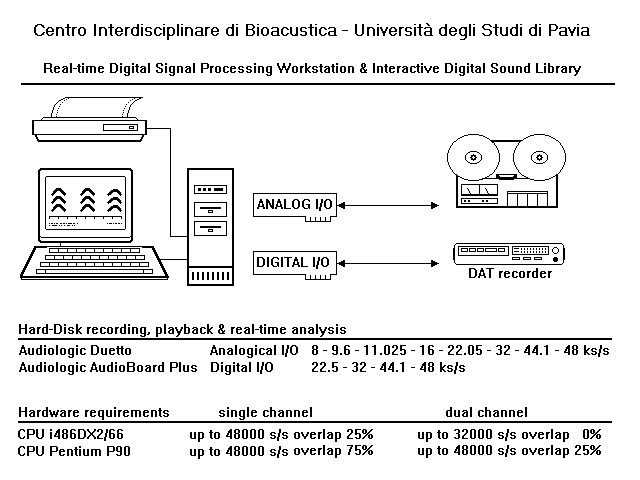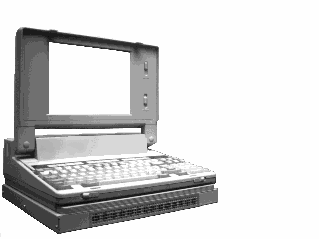 Università degli Studi di Pavia
Università degli Studi di Pavia
Centro Interdisciplinare di Bioacustica e Ricerche Ambientali
Via Taramelli 24 - 27100 Pavia - Italy
e-mail : cibra@unipv.it
Digital Signal Processing Workstation (version 1990-1994)
Spectrographic representation of animal
voices has been widely used since the first analogical
analysis instruments (Koenig et al., 1946) were developed
for military acoustic research. The development of digital
signal processing techniques and high-speed hardware at
relatively low-cost has actually made the visualization of
acoustic signals an every-day invaluable tool for
bioacoustic research and for educational purposes.
Real-time analysis is relevant in evaluating extended
audio/video recordings and is strictly required in
detecting and observing acoustic activity during
behavioural experiments and observations; moreover,
real-time techniques have proved to be relevant in
acoustic monitoring and censusing methods in the field,
both in air and underwater. The integration of high
quality acquisition boards with DSP processors on a PC
platform gives a flexibility greater then those given by
dedicated instruments. Thus, a PC based Digital Signal
Processing Workstation for bioacoustic research has been
realized (Pavan, 1992, 1994) and is continuously upgraded
to meet most of the requirements regarding the
acquisition, filing, and analysis of signals in the lab as
well as in the field.
It can be configured as a portable or desktop workstation,
with or without real-time capabilities, and can be
customized to suit specific requirements.
Low-cost sound acquisition
The basic version allows hard-disk
recording/playback and high-resolution true real-time
spectrographic analysis of sounds up to 22 kHz without the
need of expensive DSP coprocessors or external
anti-aliasing filters.
It is based on a 16 bit ISA board model Duetto made by
Audiologic (Italy). The board is characterized by a high
sound quality: two channels, simultaneous sampling, 16 bit
resolution, line input with selectable gain (0, 3, 6, 9
dB), S/N ratio 90 dB, sampling rate selectable among 8000,
9600, 11025, 16000, 22050, 32000, 44100, 48000 s/sec, on
board high-precision anti-aliasing filters (64x
oversampling with digital filtering).
Hard-disk recording can be performed in mono or stereo, in
full 16 bit linear format or with two selectable
compression algorithms (compression ratios 2:1 and 4:1) to
save disk space. In full 16 bit linear format this board
allows direct acquisition, hard disk recording and
playback of audio signals with CD or DAT quality
(Pohlmann, 1989); the length of the recordable signal is
limited only by the available storage space.
Digital I/O
Alternatively, the DSPW can be equipped with an Audiologic Audioboard Plus with digital I/O modules which allow a direct digital connection (SP-DIF) with DAT recorders. In this way, sounds are directly transferred from the DAT to the PC, and vice versa, without further Digital to Analog and Analog to Digital conversions, thus preserving the full quality of the recording.
Real-time analysis
A custom driver developed by Audiologic allows the continuous gap-free real-time DMA transfer of samples between the acquisition board(s) and the computer memory; by means of a specific software and a fast PC, recording/playback with real-time spectrographic analysis and display has been made possible at low cost on signals extending in frequency up to 22 kHz (48000 s/sec, single channel with an i486/66DX2 CPU, two channels with an Intel Pentium P90 CPU). The use of faster CPUs could further increase the performances of the DSPW, allowing, for instance, to increase the overlap factor, to enhance the detail and the smoothness of the display and to add more advanced analysis functions.

Advanced version for ultrasound analysis
The advanced version requires a DSP
(Digital Signal Processor) based acquisition board
(Microstar DAP 2400E/6, made in USA) with 16 analog inputs
and 2 output channels, 12 bit resolution, variable gain,
sampling rate up to 320000 s/sec on a single channel.
By means of the DSP, the board allows true real-time
spectrographic analysis and display of audio signals, as
well as ultrasonic signals up to 130 kHz. Spectrographic
analysis (single channel) can be performed in true
real-time up to 80 ks/sec, in pseudo real-time up to 300
ks/sec and in triggered mode up to 160 ks/sec (frequency
ranges up to 35 kHz, 130 kHz and 70 kHz respectively).
Hard disk direct recording can be performed up to 200
ks/sec, depending on the disk speed (up to 320 ks/sec on a
RAM-disk). A PC with a Pentium 200 CPU and a fast hard
disk allows real-time performances up to 320 ks/sec. The
DSP board requires an external conditioning unit to
provide amplification, high-pass and anti-aliasing
filtering of analog signals on both input and output
channels.
Integration with video recordings
The workstation can be further expanded and customized to satisfy particular requirements; by means of an external broadcast-quality video encoder, computer generated spectrographic images can be converted in a standard video signal (PAL or NTSC) to be seen on conventional TV equipments, recorded on a video-tape recorder, or mixed/inserted on live video recordings. This broadcast-quality extension can be positively used to incorporate spectrographic images of sounds in animal behaviour documentary films.
Portable DSPW
 A portable version of the DSPW
is actually based on a 16 MHz 80386SX/80387 laptop PC with
a 120 Mb Hard Disk, a VGA LCD display, two 8 bit ISA slots
holding both acquisition boards, internal battery and
external 12 Vcc powering with photovoltaic panels for
continuous operation and battery recharge. Due to the low
processing speed available on the portable unit, real-time
processing is available only throughout the DSP-based
acquisition board. A faster portable unit incorporating
both standard ISA and PCMCIA slots could dramatically
improve the application of digital processing of signals
in the field and the integration with other data
acquisition tasks such as GPS-based data logging and
tracking. Unfortunately such type of instrument is at the
moment unavailable on the market and is too expensive to
be realized as a custom project.
A portable version of the DSPW
is actually based on a 16 MHz 80386SX/80387 laptop PC with
a 120 Mb Hard Disk, a VGA LCD display, two 8 bit ISA slots
holding both acquisition boards, internal battery and
external 12 Vcc powering with photovoltaic panels for
continuous operation and battery recharge. Due to the low
processing speed available on the portable unit, real-time
processing is available only throughout the DSP-based
acquisition board. A faster portable unit incorporating
both standard ISA and PCMCIA slots could dramatically
improve the application of digital processing of signals
in the field and the integration with other data
acquisition tasks such as GPS-based data logging and
tracking. Unfortunately such type of instrument is at the
moment unavailable on the market and is too expensive to
be realized as a custom project.
Analysis software
The DSPW is equipped with its own DOS custom software designed
to acquire, store, edit, analyze and replay signals as
well as analyze them in real-time. Non-compressed digital
signal files can be edited, analyzed and/or played back to
perform play-back experiments (Pavan, 1992, 1994); also,
signal files can be easily red and processed from within
the Matlab environment.
All the spectrograms shown on our www pages have been
realized with the custom software we developed. Some of
them have been edited and labeled with standard software
tools.
Specific software was also developed to
perform some particular analysis tasks, such a two channel
envelope display, event triggering and direction finding
when searching for sperm whales with the two-channel towed
array.
A software capable of approximating the direction of an
impulsive sound source by measuring the arrival time
differences on two transducers, was developed to
acoustically find and track sperm whales. The software
actually operates in a triggered mode on two channels and
requires a good Signal to Noise Ratio to accurately detect
and continuously process sperm whale clicks in real-time.
The detection algorithm can be accurately tuned in
relation to the transducer distance, the assessed sound
speed, and the environmental background noise; also it can
be programmed to reject triggers within a specific delay
from a previously triggered event.
In spite of the left-right ambiguity due to the two
transducer design, we are able to approximate the location
of submerged animals and to discriminate and count clicks
emitted at a different bearing by two or more individuals.
Selected bibliographic references
KOENIG W., DUNN H.K., LACY L.Y., 1946. The sound
spectrograph. J.Acoust.Soc.Am., 18 (1): 19-49.
STRONG W.J., PALMER E.P., 1975. Computer-based sound
spectrograph system. J.Acoust.Soc.Am., 58 (4): 899-904.
POHLMANN K.C., 1989. Principles of Digital Audio. Howard
W.Sams & Company, Indiana, USA: 1-474.
STODDARD P.K., 1990. Audio computers. Theory of operation
and guidelines for selection of systems and components.
Bioacoustics, 2 (3): 217-239.
WILLIAMS J.M., SLATER P.J.B., 1991. Computer analysis of
bird sounds: a guide to current methods. Bioacoustics, 3
(2): 121-128.
PAVAN G., 1992. A portable DSP workstation for real-time
analysis of cetacean sounds in the field. European
Research on Cetaceans, Cambridge (UK), 6: 165-169.
PAVAN G., 1992. A portable PC-based DSP workstation for
bioacoustical research. Bioacoustics, 4 (1): 65-66.
PAVAN G., 1994. A digital signal processing workstation
for bioacoustical research. Atti 6 Conv. Ital. Ornit.,
Torino, 1991: 227-234.
PAVAN G., MANGHI M., 1994. Real-time processing and
visualization of animal sounds. Boll. Zool. Suppl., 61:
98.
Home Page of the Centro Interdisciplinare di Bioacustica e Ricerche Ambientali